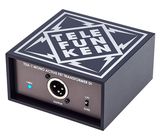Passive:
Radial Pro DI
Radial JDI
Telefunken TDP-1
Active:
Rupert Neve DI / RNDI (normal version, not the mini)
Radial J48
Telefunken TDA-1
Passive vs Active DI's:
Active DI's have a more defined sound image overall.
The level difference between the active and passive DI's is huge, 40-50% level difference! It is wise to use an active DI so the sound engineer does not have to boost your signal. Boosting = more noise, having to lowering signal / gain does not give issues.
Radial ProDI vs JDI:
JDI has more definition in low / low-mid + a bit more highs.
Telefunken's vs the rest:
The Telefunken's have a big high cut, it sound like high cut at 1000hz. (a guess, I did not measure)
They have more Low-mids then the RNDI and similair Low-mids to the Radials, but way less highs.
Rupert Neve DI and Telefunken's:
They both have (J)FET transistors inside, that gives them tube like compression. When you use a separate compressor with the RNDI or Telefunken's, especially a J(FET) compressor (1176 style), then your definition might get lost. (I experienced this myself)
If you want full control over your compression and saturation with a separate device/pedal, then the Radials are a better choice.
Rupert Neve DI vs J48:
The J48 has more definition in Low-Mids and highs.
My advice for live use:
Skip the passive DI's and the Telefunken's.
For bass-guitar use the Radial J48. For keys, acoustic and electric guitars use the Rupert Neve DI (beware angled plugs do not fit well with the 'normal RNDI', buy the M-version if you want to use angled plugs)



